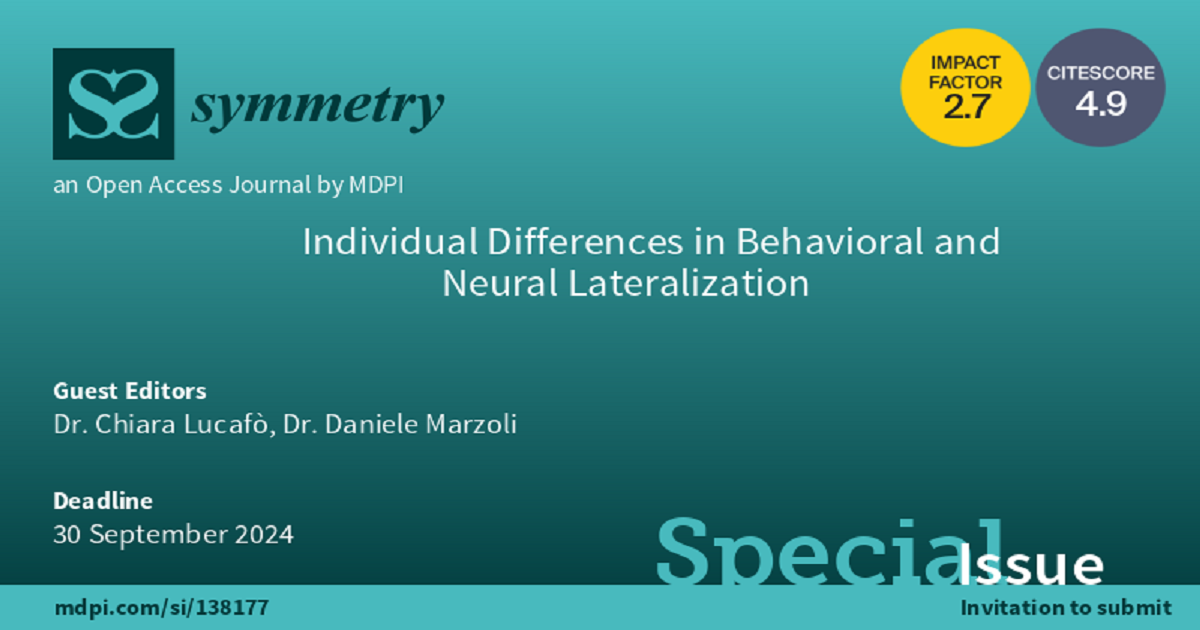Individual Differences in Behavioral and Neural Lateralization
A special issue of Symmetry (ISSN 2073-8994). This special issue belongs to the section "Life Sciences".
Deadline for manuscript submissions: 30 September 2024 | Viewed by 12183

Special Issue Editors
Interests: behavioral neuroscience
Special Issue Information
Dear Colleagues,
Research on behavioral and neural asymmetries has shown that many instances of lateralization may be affected by several individual differences. For example, it is well-known that neurodevelopmental disorders (among which those included in the autism spectrum) seem to be related to atypical patterns of lateralization. Patient with depression and anxiety disorders also exhibit abnormal lateralization. However, we point out that – even leaving aside disease-related conditions – specific laterality patterns can be linked to particular personal characteristics including, among others, sex, age, personality, sexual orientation and cognitive performance. Interestingly, the expression of various behavioral and neural asymmetries has been related to individual differences not only in humans but also in non-human species.
It should be noticed that current research is continuously unveiling further individual factors associated with specific patterns of behavioral (as regards motor, emotional, perceptual, attentional and other cognitive processes) and neural (as regards both anatomical and functional aspects) lateralization, which strongly suggests that many of them have yet to be identified. Obviously, a better understanding of the relationship between individual differences and behavioral and neural asymmetries would benefit both basic (e.g., in terms of the underlying mechanisms) and applied (e.g., in terms of diagnosis and treatment) research, and this Special Issue intends to promote such an endeavor. To this aim, we encourage the submission of both empirical and theoretical papers covering different topics (e.g., handedness, perception, attention, brain structure and functioning, genetics), different methods (e.g., behavioral, neuroimaging, meta-analytic) and different populations (e.g., human and non-human, clinical and non-clinical, young and elderly).
Dr. Chiara Lucafò
Dr. Daniele Marzoli
Guest Editors
Manuscript Submission Information
Manuscripts should be submitted online at www.mdpi.com by registering and logging in to this website. Once you are registered, click here to go to the submission form. Manuscripts can be submitted until the deadline. All submissions that pass pre-check are peer-reviewed. Accepted papers will be published continuously in the journal (as soon as accepted) and will be listed together on the special issue website. Research articles, review articles as well as short communications are invited. For planned papers, a title and short abstract (about 100 words) can be sent to the Editorial Office for announcement on this website.
Submitted manuscripts should not have been published previously, nor be under consideration for publication elsewhere (except conference proceedings papers). All manuscripts are thoroughly refereed through a single-blind peer-review process. A guide for authors and other relevant information for submission of manuscripts is available on the Instructions for Authors page. Symmetry is an international peer-reviewed open access monthly journal published by MDPI.
Please visit the Instructions for Authors page before submitting a manuscript. The Article Processing Charge (APC) for publication in this open access journal is 2400 CHF (Swiss Francs). Submitted papers should be well formatted and use good English. Authors may use MDPI's English editing service prior to publication or during author revisions.
Keywords
- behavioral lateralization
- neural lateralization
- individual differences
- mental disorders
- atypical lateralization
- handedness
- motor asymmetries
- perceptual and attentional asymmetries
- sex
- age
- personality
- sexual orientation
- cognitive performance
- genetics





